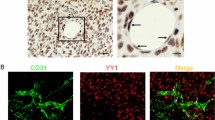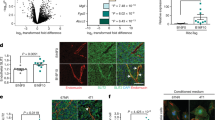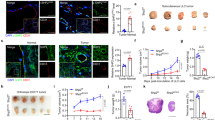Abstract
The growth of solid tumours requires a blood supply provided by re-modeling of existing blood vessel endothelium (angiogenesis). Little is known about transcription regulators which are specific for the control of tumour angiogenesis. The proto-oncogene LMO2 encodes a LIM domain transcription regulator which controls angiogenesis during mouse embryogenesis where it regulates remodelling of the capillary network into mature vessels. We now show that Lmo2 expression is augmented in tumour endothelium such as mouse thymomas and human lung tumours. The functional significance of this Lmo2 expression was assessed in teratocarcinomas induced in nude mice by subcutaneous implantation of Lmo2-lacZ targeted ES cells. CD31-positive, sprouting endothelium of ES-cell origin occurred in teratocarcinomas from heterozygous Lmo2-lacZ ES cells but none occurred from null Lmo2-lacZ ES cells. Therefore, in this model Lmo2 is an obligatory regulator of neo-vascularization of tumours. These data suggest that LMO2 function may be a drug target in cancer and other conditions characterized by neo-vascularization.
This is a preview of subscription content, access via your institution
Access options
Subscribe to this journal
Receive 50 print issues and online access
$259.00 per year
only $5.18 per issue
Buy this article
- Purchase on Springer Link
- Instant access to full article PDF
Prices may be subject to local taxes which are calculated during checkout




Similar content being viewed by others
References
Boehm T, Foroni L, Kaneko Y, Perutz MP, Rabbitts TH . 1991 Proc. Natl. Acad. Sci. USA 88: 4367–4371
Carmeliet P, Jain RK . 2000 Nature 407: 249–257
Chang YS, Di Tomaso E, McDonald DM, Jones R, Jain R, Munn LL . 2000 Proc. Natl. Acad. Sci. USA 97: 14608–14613
Ferrara N, Alitalo K . 1999 Nat. Med. 5: 1359–1364
Folkman J . 1971 N. Engl. J. Med. 285: 1182–1186
Folkman J . 1972 Ann. Surg. 175: 409–416
Folkman J . 1995 Nat. Med. 1: 27–31
Hanahan D, Folkman J . 1996 Cell 86: 353–364
Harvey M, McArthur MJ, Montgomery CAJ, Butel JS, Bradley A, Donehower LA . 1993 Nature Genetics 5: 225–229
Rabbitts TH . 1994 Nature 372: 143–149
Rabbitts TH . 1998 Genes & Devel. 12: 2651–2657
Rafii S . 2000 J. Clin. Investig. 105: 17–19
Robb L, Elwood NJ, Elefanty AG, Kontgen F, Li R, Barnet LD, Begley CG . 1996 EMBO J. 15: 4123–4129
Royer-Pokora B, Loos U, Ludwig W-D . 1991 Oncogene 6: 1887–1893
Schmeichel KL, Beckerle MC . 1994 Cell 79: 211–219
Tanière P, Martel-Planche G, Maurici D, Lombard-Bohas C, Scoazec J-Y, Montesano R, Berger F, Hainaut P . 2001 Am. J. Pathol. 158: 33–40
Valge-Archer VE, Osada H, Warren AJ, Forster A, Li J, Baer R, Rabbitts TH . 1994 Proc. Natl. Acad. Sci. USA 91: 8617–8621
Visvader JE, Fujiwara Y, Orkin SH . 1998 Genes & Devel. 12: 473–479
Wadman I, Li J, Bash RO, Forster A, Osada H, Rabbitts TH, Baer R . 1994 EMBO J. 13: 4831–4839
Warren AJ, Colledge WH, Carlton MBL, Evans MJ, Smith AJH, Rabbitts TH . 1994 Cell 78: 45–58
Weidner N, Semple JP, Welch WR, Folkman J . 1991 N. Eng. J. Med. 324: 1–8
Yamada Y, Pannell R, Forster A, Rabbitts TH . 2000 Proc. Natl. Acad. Sci. USA 97: 320–324
Yamada Y, Warren AW, Dobson C, Forster A, Pannell R, Rabbitts TH . 1998 Proc. Natl. Acad. Sci. USA 95: 3890–3895
Acknowledgements
We would like to thank Matt McCormack for discussions during this work and Gareth King, Theresa Langford, Angela Middleton and Tina Hamilton for expert help. Y Yamada was generously supported by an award from the National Foundation for Cancer Research, USA. We also wish to thank Peter Goldstraw for the lung tumour biopsies used in this work.
Author information
Authors and Affiliations
Corresponding author
Rights and permissions
About this article
Cite this article
Yamada, Y., Pannell, R., Forster, A. et al. The LIM-domain protein Lmo2 is a key regulator of tumour angiogenesis: a new anti-angiogenesis drug target. Oncogene 21, 1309–1315 (2002). https://doi.org/10.1038/sj.onc.1205285
Received:
Accepted:
Published:
Issue Date:
DOI: https://doi.org/10.1038/sj.onc.1205285
Keywords
This article is cited by
-
The transcription factor complex LMO2/TAL1 regulates branching and endothelial cell migration in sprouting angiogenesis
Scientific Reports (2022)
-
LIM-domain-only proteins in cancer
Nature Reviews Cancer (2013)
-
GATA2 and Lmo2 control angiogenesis and lymphangiogenesis via direct transcriptional regulation of neuropilin-2
Angiogenesis (2013)
-
The regulatory epicenter of miRNAs
Journal of Biosciences (2011)



